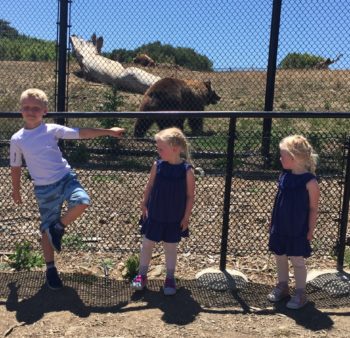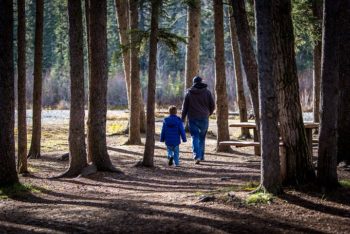Embracing Spring Rain: Strategies to Get Kids Outdoors
For my 40th birthday, I was surprised with a trip to Vancouver. As I packed my bags, I was told to bring rain gear—there was no way my family was going to let me stay inside just because of a little rain. I was there to explore, not to hide indoors. The same is true for kids in the spring. Just because it’s rainy or chilly doesn’t mean outdoor play has to stop!
Everyone needs outdoor time, no matter the forecast. In many schoo ls, rainy days mean canceled recess, and that lack of movement can lead to restlessness and frustration. Getting outside, even in less-than-ideal weather, helps with attention, sensory processing, and emotional regulation.
ls, rainy days mean canceled recess, and that lack of movement can lead to restlessness and frustration. Getting outside, even in less-than-ideal weather, helps with attention, sensory processing, and emotional regulation.
The truth is, outdoor play is just as important in spring as in any other season. Movement helps kids regulate their bodies, develop motor skills, and improve focus. Plus, time spent in nature is proven to reduce stress and boost mood.
Why Outdoor Play Matters in the Spring
-
Supports Physical Health
Jumping in puddles, running through wet grass, and climbing damp playground equipment all help kids build strength, balance, and coordination. Exposure to natural light helps regulate sleep cycles and provides a much-needed vitamin D boost after winter.
-
Helps with Emotional Regulation
Many children, especially those with ADHD, sensory processing challenges, or anxiety, benefit from movement. Physical activity releases dopamine and serotonin, the brain’s “feel-good” chemicals, which can help kids feel calmer and more focused.
-
Reduces Screen Time
With unpredictable spring weather, it’s tempting to stay indoors with screens. While technology has its place, too much screen time can lead to increased irritability, poor sleep, and reduced physical activity. Getting outside—even in the rain—provides a much-needed break.
-
Encourages Creativity and Problem-Solving
Rain and mud offer new ways to play—from making mud pies to floating homemade boats in puddles. Outdoor play challenges kids to think creatively, explore textures, and engage in unstructured, imaginative activities.
Strategies to Get Outside and Enjoy Rainy Spring Days
-
Dress for Success: Waterproof Layers are Key
The biggest barrier to outdoor play in the rain is often being wet and cold. The right clothing makes all the difference. Use a layering strategy to stay dry and warm:
- Base layer: Moisture-wicking materials like wool or synthetic fabrics to keep skin dry
- Middle layer: Fleece or a lightweight sweater for warmth
- Outer layer: A waterproof, wind-resistant raincoat and rain pants
- Accessories: Waterproof boots, rain gloves, and a hat with a brim to keep raindrops out of eyes
-
Make Outdoor Time a Game
If kids are reluctant to go outside, turn it into an adventure. Fun spring outdoor activities:
- Puddle Jumping Contest: See who can make the biggest splash.
- Rainy Day Scavenger Hunt: Look for worms, raindrops on leaves, or reflections in puddles.
- Floating Boat Race: Make small boats from leaves, bark, or paper and race them down a stream or puddle.
- Mud Kitchen Play: Let kids mix mud, sticks, and leaves to create “recipes.”
-
Create a Routine for Outdoor Play
When outdoor time becomes a daily habit, kids adjust to it—even in the rain. Ways to build a routine:
- Morning Movement: A short walk before school can help wake up the brain.
- After-School Play: Instead of heading straight for screens, spend 20–30 minutes outside first.
- Weekend Adventures: Plan a family outing to a park, even if the weather is damp.
-
Find Rain-Friendly Destinations
Sometimes a change of scenery makes all the difference. Great places to visit in the rain:
- Nature trails: Many parks remain accessible and offer beautiful rainy-day scenery.
- Creeks and streams: Spring rain fills creeks and is perfect for floating sticks and boats.
- Botanical gardens: Some have covered areas for rainy-day exploring.
- Outdoor markets: Farmers’ markets still run in light rain, and kids can help pick out seasonal produce.
-
Get Involved in Spring Sports
If your child struggles with free play, structured activities may help. Popular rainy-day outdoor activities:
- Soccer: Wet grass makes for fun sliding kicks.
- Hiking: Trails are peaceful after a rain shower, and the smells of wet earth and blooming flowers can be soothing.
- Cycling: A light drizzle won’t stop the fun, and kids love riding through puddles.
- Fishing: Rainy days often mean better fishing conditions.
-
Use Sensory-Friendly Strategies
Some kids, especially those with sensory sensitivities, find rain overwhelming. The feel of wet clothes, the sound of raindrops, and the smell of damp earth can lead to sensory overload. Ways to help include:
- Let kids play with water indoors first (e.g., with a water table or sink play) before venturing outside.
- Choose soft, tagless clothing to prevent irritation.
- Offer waterproof gloves for kids who dislike the feel of wet hands.
- Use noise-canceling headphones for kids sensitive to the sound of rain.
-
Incorporate Warm-Up Breaks
Cold, wet play doesn’t have to mean staying outside for hours. Make sure kids stay comfortable. Ideas for warm-up breaks:
- Drink hot cocoa or warm tea inside after playing.
- Set a timer for 20-30 minutes outside, then take a short indoor break.
- Create a “warm-up station” with blankets and cozy socks.
-
Make It a Family Activity
Kids are more likely to embrace rainy-day play if parents participate. Ways to make it fun for the whole family:
- Plan a rainy-day nature walk and listen for different sounds of water.
- Take turns choosing outdoor activities for each outing.
- Start a spring tradition, like an annual “Puddle Walk.”
Bringing the Outdoors Inside. On days when it’s just too stormy to go out, bring nature inside. Indoor nature activities include:
- Rain Painting: Let raindrops mix with watercolor paints on paper.
- Indoor Planting: Start a small herb garden in pots near a window.
- Sensory Bins: Fill a bin with damp soil, rocks, or pinecones for a nature-inspired sensory experience.
Spring rain doesn’t have to mean staying inside! With the right gear, creative activities, and a bit of planning, kids can enjoy fresh air, movement, and outdoor fun—even on drizzly days. By embracing outdoor play, you can set an example, help kids build resilience, burn energy, and develop a love for nature in all seasons.
 Teaching Kids How to Be Kind
Teaching Kids How to Be Kind Summer Boundaries for Kids!
Summer Boundaries for Kids! ls, rainy days mean canceled recess, and that lack of movement can lead to restlessness and frustration. Getting outside, even in less-than-ideal weather, helps with attention, sensory processing, and emotional regulation.
ls, rainy days mean canceled recess, and that lack of movement can lead to restlessness and frustration. Getting outside, even in less-than-ideal weather, helps with attention, sensory processing, and emotional regulation. Exploring Nature: Outdoor Adventures for Children
Exploring Nature: Outdoor Adventures for Children Camping Adventures for ALL Children
Camping Adventures for ALL Children